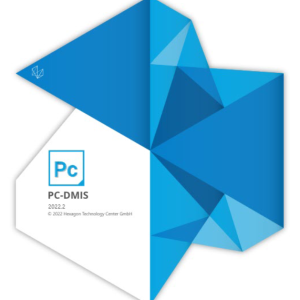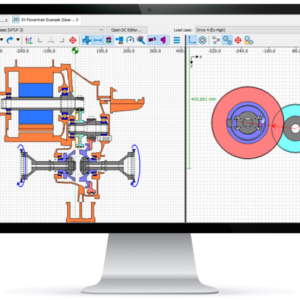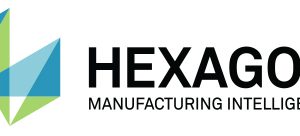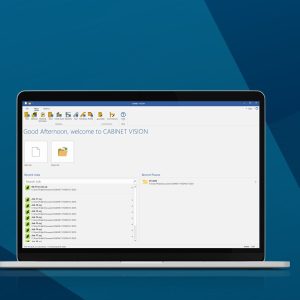Adams 2023.4 cracked release
$ 150.00
Study the dynamics of moving parts, and how loads and forces are distributed throughout mechanical systems. Efficiently display the flexibility of products through conventionally intuitive systems, for definitive accuracy. Design accurate mechanical models for desired kinetics and functions confidently and test with optimized control. Accelerate ambitious projects by exploring and analyzing multiple design concepts simultaneously.
Description
Adams 2023.4 Release Highlights
Some main highlights of this release include the following:
Adams Car:
- New menu structure: The menus in Adams Car have been reorganized to make essential functions more easily discovered.
- New API for optimization & multi-run applications: A new Application Programming Interface (API) for Adams Car has been created to simplify the process of simulating & evaluating Adams Car models.
- Improvements to low-speed reverse parking events: Robustness improvements have been made to the Driving Machine that is used in machine-controlled parking events, specifically for driving in reverse.
.
Adams Solver:
- New contact measurement functions: A new function; CONTACT_DATA(id, comp, flag) provides the following CONTACT parameters:
- Penetration Depth
- Penetration Velocity
- Penetration Boring Velocity
- Slip Deformation Magnitude
- Slip Velocity Magnitude (Speed)
- Contact performance improvement: Performance improvement of up to 3X in wall time can be realized in simulations involving rigid body contact with HHT integrator. This speed up will depend on model size and number of Euler singularities that the solver has to process during the simulation.
Adams Postprocessor:
- New 2d order plots from 3d FFT plots: This new functionality allows a user to create a 2D Curve Slice from an existing 3D FFT plot.
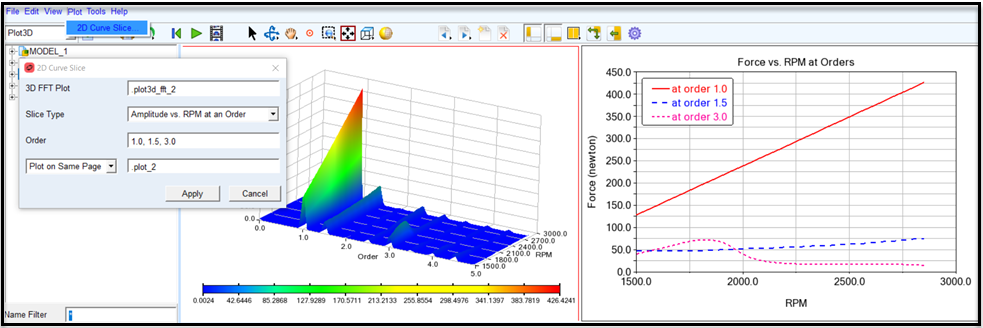
Seamlessly analyze the dynamics of moving parts
Evaluate and manage the complex interactions between Multibody Dynamics disciplines using Adams’ innovative tool suite, optimizing products for performance and safety. Adams’ system-level design validation allows for swift improvements in a project’s early stages. Other benefits include:
Build and analyze realistic MBD models for complex systems in minutes
Examine moving parts (cars, tires, wind turbines, powertrains, or robotic systems) in detailed realistic environments formed with real-world physics. Adams can deliver meticulous results in easy-to-understand formats. Its pre-built templates work like a charm to deliver accuracy efficiently.
01
Adams Modeler
The Adams Modeler is equipped with a powerful, next-generation pre- and post-processor, enabling you to render models with an incredibly realistic level of detail and physics.
02
Adams Car
Simulate all aspects of vehicle dynamics with a specifically tailored vertical application, armed with tools that push the boundaries of car physics simulations for design-perfect results.
03
Adams Machinery
Enhance machine processes using Adams’ vertical tool suite, to fine-tune all aspects of design prior to prototyping and production.
04
Adams Real Time
Adams RT empowers engineers to flawlessly integrate and simulate a high-fidelity mechanical systems MBD model with hardware and control software (XiL) in Real Time.
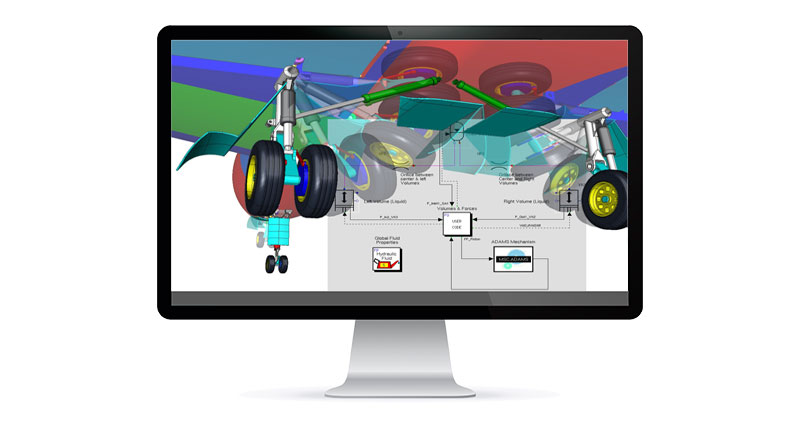
Adams helps engineers to study the dynamics of moving parts, and how loads and forces are distributed throughout mechanical systems.
Product manufacturers often struggle to understand true system performance until very late in the design process. Mechanical, electrical, and other subsystems are validated against their specific requirements within the systems engineering process, but full-system testing and validation comes late, leading to rework and design changes that are riskier and more costly than those made early on.
Simulate “Real World” physics
As the world’s most famous and widely used Multibody Dynamics (MBD) software, Adams improves engineering efficiency and reduces product development costs by enabling early system-level design validation. Engineers can evaluate and manage the complex interactions between disciplines including motion, structures, actuation, and controls to better optimize product designs for performance, safety, and comfort. Along with extensive analysis capabilities, Adams is optimized for large-scale problems, taking advantage of high performance computing environments.
Utilizing multibody dynamics solution technology, Adams runs nonlinear dynamics in a fraction of the time required by FEA solutions. Loads and forces computed by Adams simulations improve the accuracy of FEA by providing better assessment of how they vary throughout a full range of motion and operating environments.

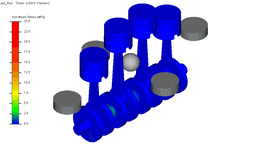

“Adams simulations permitted us to get different loading conditions to be studied through an FE analysis, putting to evidence the most critical loading combinations,”
Bianchi F – AgustaWestland
Adams Multidiscipline Solutions
Optional modules available with Adams allow users to integrate mechanical components, pneumatics, hydraulics, electronics, and control systems technologies to build and test virtual prototypes that accurately account for the interactions between these subsystems.
Adams Controls and Adams Mechatronics – Integrate Adams with your controls applications
 Adams Mechatronics is a plug-in to Adams which can be used to easily incorporate control systems into mechanical models. Adams Mechatronics has been developed based on the Adams Controls functionality and contains modeling elements which transfer information to/from the control system.
Adams Mechatronics is a plug-in to Adams which can be used to easily incorporate control systems into mechanical models. Adams Mechatronics has been developed based on the Adams Controls functionality and contains modeling elements which transfer information to/from the control system.
For example, using Adams Mechatronics in Adams Car, you can quickly create assemblies of vehicle systems including control systems, and then analyze them to understand their performance and behavior.
- Add a sophisticated controls representation to your Adams model
- Connect your Adams model to block diagram models you’ve developed with control applications such as Easy5® or MATLAB®
- Experience flexibility in simulation styles to suit your problems’ needs: simulate within Adams, within the controls software or co- simulation
- Access advanced pre-processing for Adams Controls
- Setup and couple a control system to a mechanical system
- Convert signal units automatically
- Connect transducer and actuator signals to the control systems easily
- Conveniently review and modify the control system input and output specifications
- Ideal for complex integrations
Adams Flexible Body Integration – Adams Flex and Adams Viewflex
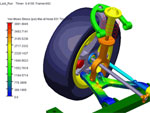 Adams Flex provides the technology to correctly include a component’s flexibility even in presence of large overall motion and complex interaction with other modeling elements. Greater emphasis has been placed these days on high-speed, lightweight, precise mechanical systems. Often these systems will contain one or more structural components where deformation effects are paramount for design analyses and the rigid body assumption is no longer valid.
Adams Flex provides the technology to correctly include a component’s flexibility even in presence of large overall motion and complex interaction with other modeling elements. Greater emphasis has been placed these days on high-speed, lightweight, precise mechanical systems. Often these systems will contain one or more structural components where deformation effects are paramount for design analyses and the rigid body assumption is no longer valid.
Adams Flex allows importing finite element models from most major FEA software packages and is fully integrated with Adams package providing access to convenient modeling and powerful post-processing capabilities.
- Integrate FEA-based flexible bodies into your model
- Better represent structural compliance
- Predict loads and displacements with greater accuracy
- Examine the linear system modes of a flexible model
- Broad and convenient control over modal participation and damping
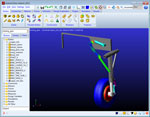 The ViewFlex module in Adams View enables users to transform a rigid part to an MNF-based flexible body using embedded finite element analysis where a meshing step and linear modes analysis will be performed. It is our new product module powered by MSC Nastran, allowing one to create flexible bodies without leaving Adams View and without reliance on 3rd party Finite Element Analysis software. Also, it’s a streamlined process with much higher efficiency than the way users have traditionally generated flexible bodies for Adams in the past.
The ViewFlex module in Adams View enables users to transform a rigid part to an MNF-based flexible body using embedded finite element analysis where a meshing step and linear modes analysis will be performed. It is our new product module powered by MSC Nastran, allowing one to create flexible bodies without leaving Adams View and without reliance on 3rd party Finite Element Analysis software. Also, it’s a streamlined process with much higher efficiency than the way users have traditionally generated flexible bodies for Adams in the past.
- Create flexible bodies entirely within Adams View or Adams Car
- Reduce reliance on 3rd party FEA software using built in MSC Nastran technology
- Generate a flexible body from existing solid geometry, imported meshes or newly created extrusion geometry
- Obtain detailed control over mesh, modal analysis and flexible body attachment settings for an accurate representation of component flexibility
Adams Durability – Integrate with MSC Fatigue to do component life prediction
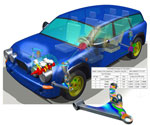
Durability testing is a critical aspect of product development and issues discovered late in the development cycle lead to project delays and budget overruns. Worse yet, “in service” failures lead to dissatisfied customers, safety issues, and warranty costs. Adams Durability allows engineers to assess stress, strain or life of components within mechanical systems to design products to last. Direct access to physical test data in industry-standard file formats enables engineers to use loads data captured during tests, and to easily correlate simulation and testing results.
- Shorten your development cycle, reducing costly durability testing
- Provide direct file input and output in RPC III and DAC formats to reduce disk space requirements and improve performance
- Perform modal stress recovery of flexible bodies within Adams
- Export loads to popular FEA software including MSC Nastran for detailed stress analysis
- Integrate with MSC Fatigue to do component life prediction
Adams Vibration – Create input and output channels for vibration analyses
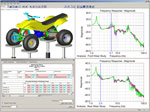
With Adams Vibration, engineers replace physical tests on shaker devices with virtual prototypes. Noise, vibration, and harshness (NVH) are critical factors in the performance of many mechanical designs but designing for optimum NVH can be difficult. Adams Vibration allows engineers to easily study forced vibration of mechanical systems using frequency domain analysis.
- Analyze the forced response of a model in the frequency domain over different operating points
- Transfer your linearized model from Adams products to Adams Vibration completely and quickly
- Create input and output channels for vibration analyses
- Specify frequency domain input functions, such as swept sine amplitude/ frequency, power spectral density (PSD), and rotational imbalance
- Create frequency-based forces
- Solve for system modes over frequency range of interest
- Evaluate frequency response functions for magnitude and phase characteristics
- Animate forced response and individual mode response
- Tabulate system modal contributions to forced vibration response
- Tabulate contribution of model elements to kinetic, static, and dissipative energy distribution in system modes
- Specify direct kinematic inputs
- Plot Stress/Strain frequency response functions



